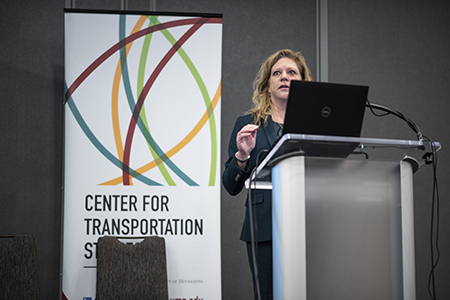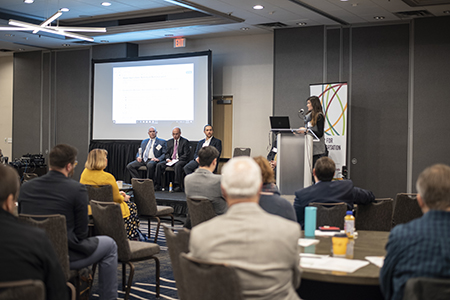When Category 5 Hurricane Katrina hit Florida and Louisiana in August 2005, it caused more than 1,200 deaths and $125 billion in damages. To make matters worse, it became apparent during the cleanup process that the response effort lacked sufficient communication and planning.
“Nobody knew who was in charge of anything,” said symposium speaker Bethany Stich, director of the University of New Orleans Transportation Institute.
Every second matters in a natural disaster, Stich added, so roles need to be clear ahead of time and politics must not be allowed to influence the process. Moreover, plans must be made and practiced ahead of time. But, she said, the response to Katrina lacked a lot of these things.
Symposium panelist Dan Murray, senior vice president at the American Transportation Research Institute, said that communication is often the biggest barrier to recovery and reentry during a disaster. For example, fluid communication is needed between the private and public sectors about road closures and downed bridges, and orders to determine what goes where need to be coordinated.
“The communication system in Katrina did not go well,” Murray said.
Semis with 53-foot trailers and loads of blankets, food, and generators were being routed down small roads because no one knew where they were supposed to go, and supply trucks had to fight the outgoing rush of traffic attempting to flee the city.
Maintaining up-to-date but adaptable plans is a big part of solving many of these problems. On a federal level, there is a list of priorities—emergency support functions—that responders with FEMA address in order, beginning with transportation.
Symposium speaker Jeffrey Dorko, assistant administrator for logistics at the FEMA Office of Response and Recovery, said that these planned priorities often change once the actual disaster hits. Good relationships and contingencies, therefore, need to be baked into the plan to ensure disaster response is nimble and adaptable. “No plan is going to survive the storm or survive the earthquake,” he said.
Speaking from a private-sector perspective, symposium panelist Emily Richards said her company keeps plans ready throughout the year. When a natural disaster strikes, the business keeps an eye on the situation and updates the plan accordingly. Richards, a C.H. Robinson account manager assigned to Lowe’s, said specifics often change. However, if the fundamentals are there and everyone knows their role, things stand a good chance of going smoothly.
Communication and coordination also are needed between the public and private sectors, Dorko added. In particular, private companies often have data and logistical capabilities from which government agencies could benefit, and private businesses need to know where they should be and when to deliver their supplies.
“Being able to start those conversations early, before the disaster hits, and start preparing for it, is very critical,” said symposium panelist Mark Berndt, freight planning practice leader with Quetica Consulting and Engineering.

